Samsung Galaxy S 4 Review - Part 1
by Brian Klug on April 24, 2013 12:01 AM ESTDisplay
We wrote about how we suspected that SGS4 would go to a 5-inch 1080p SAMOLED display just after CES. Turns out that was spot on, as the SGS4 includes a 5-inch 1080p Full HD SAMOLED panel, the latest in Samsung's AMOLED roadmap. Samsung's naming stays true, and there's no Plus tacked on at the end, so we get another non-RGB stripe subpixel geometry with SGS4. The last few Samsung AMOLED variants we've seen have had different subpixel grids, and the one on the SGS4 is possibly the most interesting to date. There's still a bias toward more green subpixels than blue or red, this isn't an RGB stripe at all, but instead of the previous RG,BG layout we see this offset pattern with green on one line, then blue and red on another line. Interestingly enough the blue subpixel appears to be a square, and red and green appear to be circles, with the difference in area possibly offsetting the luminous efficiency of each material. Whatever the reason (Samsung has never been official or forthcoming any of these subpixel patterns each time they've changed them) it's present on the SGS4.
At this size however I have to admit that I find the pursuit of the subpixel geometry more of an educational one than something which affects users. While I could occasionally see it on the SGS3, I definitely do not see it on SGS4. The subpixels are now small enough that whatever the pattern, it all looks like a homogenous light-emitting surface, which was the goal after all. I could bring up the visual acuity discussion again but just trust me that it's small enough to not be visible even with actually perfect (not legally perfect, which is different) vision.
So resolution is great and up to par with all the other LCD-bearing flagships this year, lack of RGB stripe notwithstanding. There's that remaining question about brightness, contrast, outdoor visibility, and of course calibration and the saturation issue that has persisted with AMOLED from generation to generation.
On the brightness front, the SGS4 includes dynamic contrast functions that cannot be disabled and change as a function of what is being displayed. There's an "auto adjust screen tone" checkbox under display but don't let that fool you, that doesn't disable dynamic contrast, just white point. Under screen mode are the mDNIe toggles we've seen on countless other previous Samsung Android phones with AMOLED panels, only here we notice something interesting. There have always been four toggles as long as this option has existed, only what's different is now, one of them is named "Professional photo." Reviews of other regional variants of the SGS4 have included the same button but marked "Adobe RGB." Oddly enough it seems that the North American versions at least have this renamed for some reason, but undoubtedly the function is the same. Many speculated that this is now a toggle for some full CMS (Color Management System) which "fixes" the inherent color space issues with AMOLED and oversaturation that occurs when looking at sRGB content on such devices. Unfortunately, I can confirm that my initial suspicions that this is just a continuation of the mDNIe (lite) settings from previous generation is in fact correct. I reverse engineered what I could of these settings from both kernel messages while changing the toggles, and looking at the kernel sources. Turns out that 'Professional photo' mode is actually the 'Natural' mode renamed from previous versions.
So the question was whether the color space or white point actually does change with this mode enabled. I ran the SGS4 through our display tests in each of the modes and think the full color space plot tells the story. The sanest of them all really ends up being the strangely-named 'Movie' mode. Professional photo gives the big gamut with a white point closer to 'Movie,' which is to say around 7000K, but it doesn't fundamentally change the still-present oversaturation or color management issue that exists in Android with these wide gamut displays. Most users admittedly don't care however and just see "bright" colors. Theres' an Auto mode as well which the device ships with that basically has a matrix of mDNIe settings for targeted applications (for example the Gallery, Browser, Video playback) and so forth get settings, which you can see in the kernel.
| CalMAN Display Comparison | ||||||||||||
| Metric | iPhone 5 | iPhone 4S | HTC One X | SGS3 | Samsung Galaxy Note 2 | Google Nexus 4 | HTC Droid DNA | HTC One | SGS4 | |||
| Grayscale 200nits Avg dE2000 | 3.564 | 6.162 | 6.609 | 4.578 | 5.867 | 7.686 | 6.738 | 5.391 | 7.511 | |||
| CCT Avg (K) | 6925 | 7171 | 5944 | 6809 | 7109 | 8506 | 8108 | 8118 | 7020 | |||
| Saturation Sweep Avg dE2000 | 3.591 | 8.787 | 5.066 | 5.460 | 7.986 | 8.517 | 5.856 | 3.365 | 7.823 | |||
| GMB ColorChecker Avg dE2000 | 4.747 | 6.328 | 6.963 | 7.322 | 8.185 | 7.531 | 6.687 | 4.656 | 7.440 | |||
In the "Movie" mode things are better controlled than the Note 2 on the GMB color checker card test, which is the most important one for me. White point is also no longer the crazy 8000K that we saw before, 7000K is commendable for Samsung at this point. Keep in mind that maximum brightness changes in each mode as well as we effectively clamp things, I measured a maximum of 319 nits in Dynamic mode, 311 nits in Movie mode, and 255 nits in Standard, for example.
Running the display at maximum brightness for too long will also get you into an overheating or thermal protection mode as well, which we've seen on countless other AMOLED variants. Most of the time I suspect users will run on Auto brightness however which keeps brightness down to a much lower level to save battery and prevent that from becoming a problem.
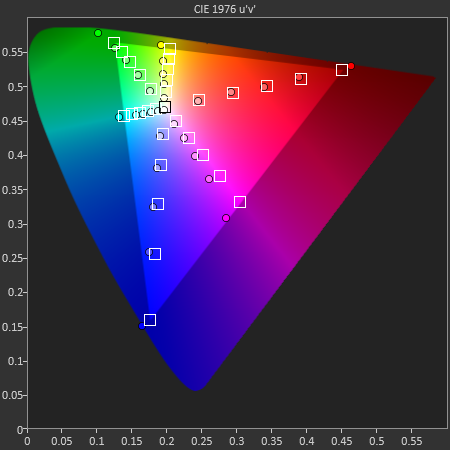
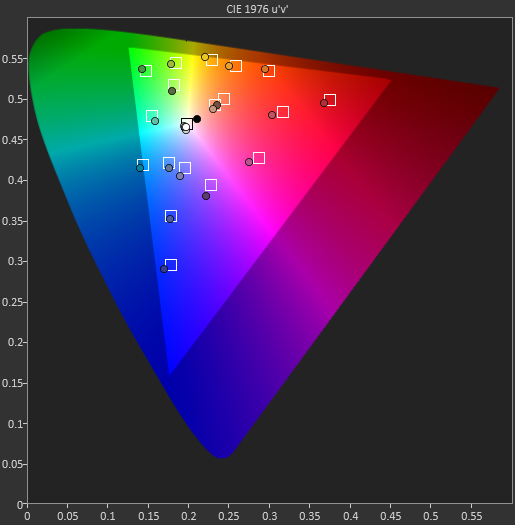
Because "Movie" was the closest to sRGB of all the modes, I selected it for the actual results that I'll present in the table. Admittedly this mode does tighten things up a bit, but it still isn't perfect and I'd still like to see Samsung do something to reign this in at some point.


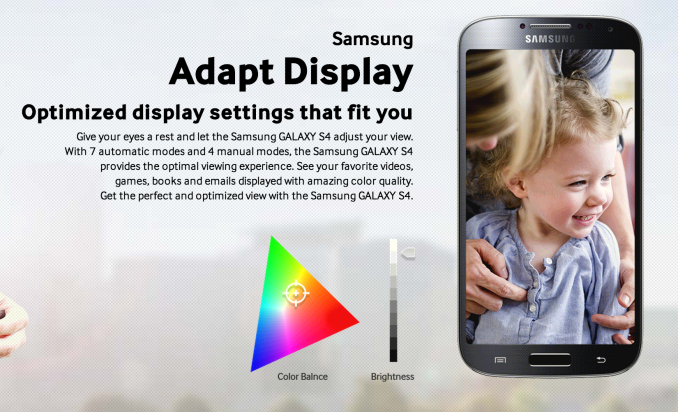




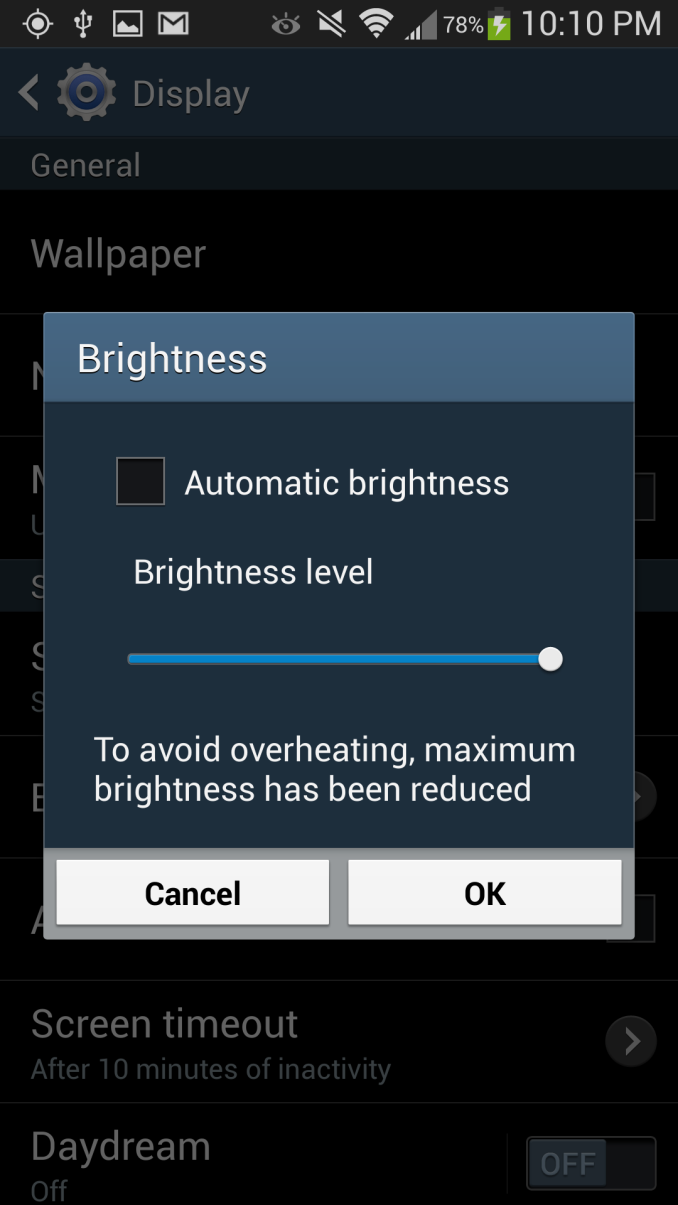
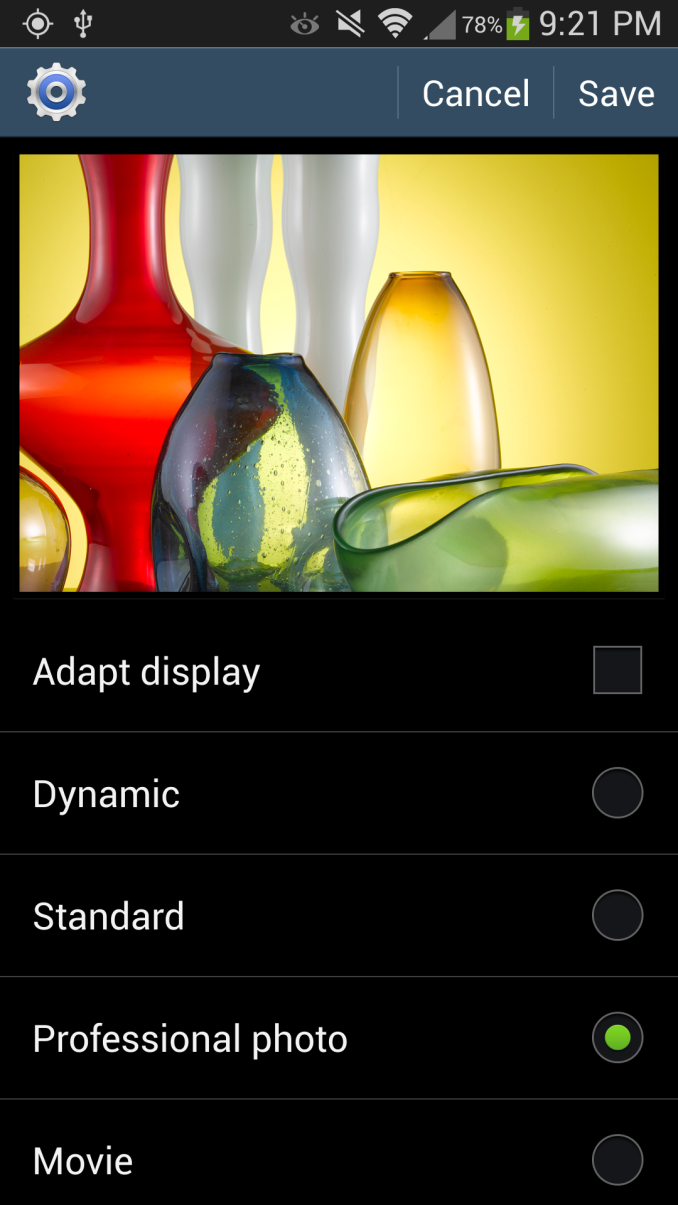
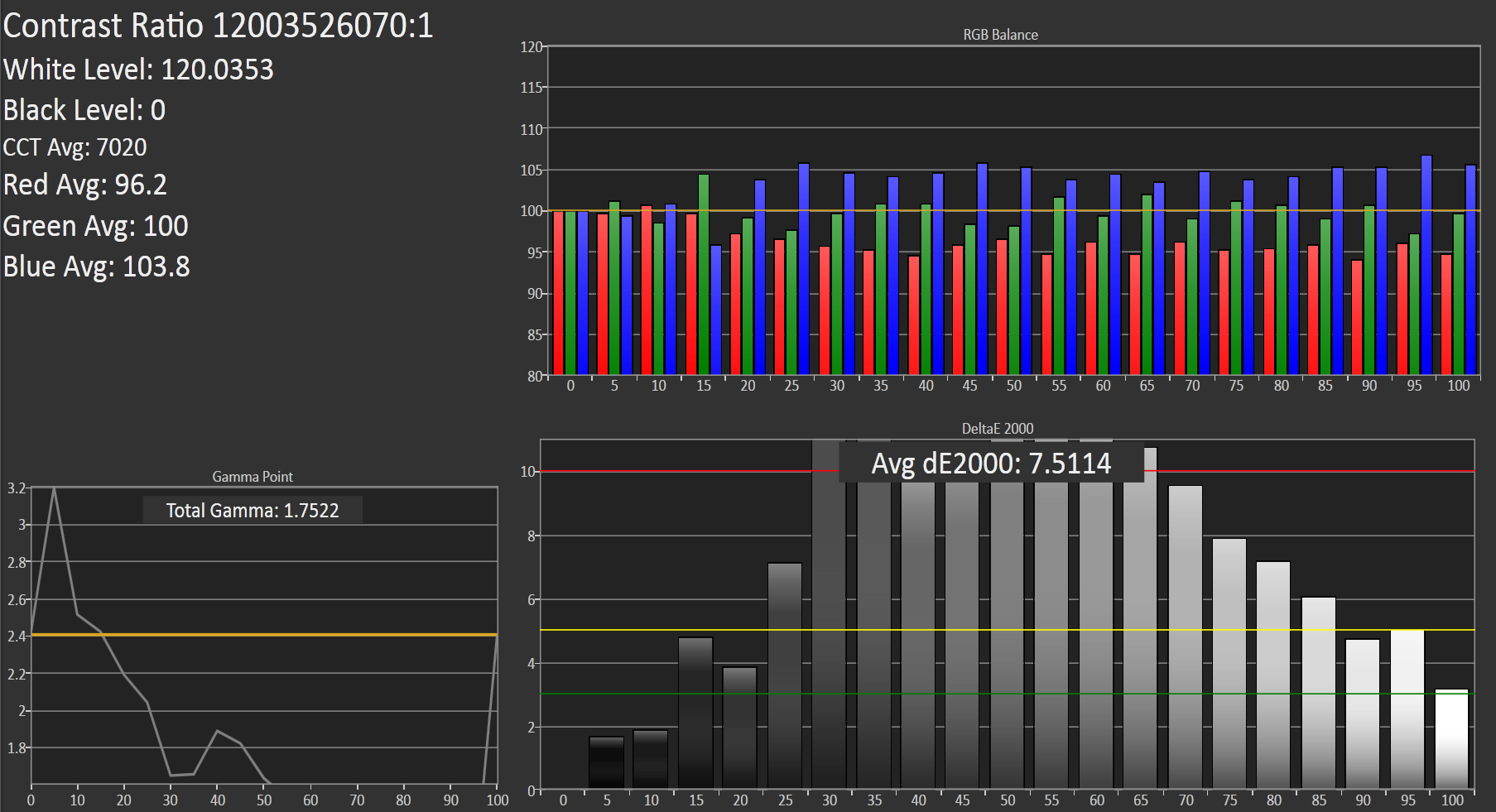








335 Comments
View All Comments
superflex - Friday, May 3, 2013 - link
Quit being a drama queen.My three year old HTC EVO 4G has the original battery and still gets me through a day just fine.
xaml - Friday, April 26, 2013 - link
This is one beautiful device, if you can't see that and you're trying to blame the materials for it, I'm sorry but it shows.Random Kkkkk - Friday, April 26, 2013 - link
" what will probably be 2013's most popular smartphone" Did you somehow forget about Apples iPhone 5? You can't be serious if you think this will outsell it considering the iPhone 5 has had a quarter of sales already.Spikey01 - Friday, April 26, 2013 - link
There is a difference between popular and units sold...The S4 will be a huge sucess!!
medi02 - Sunday, April 28, 2013 - link
Check charts on these page:http://tech.fortune.cnn.com/2013/03/16/apple-iphon...
Galaxy is only slightly behind iphone sales, on the other hand, its sales were doubling with every release.
puremind - Friday, April 26, 2013 - link
Brian, what color meter do you use for display checks? The color temperature on the HTC One in your comparison seems like an overestimation. In my measurements, it should be 7200K for the Taiwan factory (serial numbers starting with HT) and 6670K for the Argentina factory (serial number starting with FA).It does not change the results, though, seeing as all your phones are measured with the same color meter, this is still a fair comparison.
Just to give you an idea, on the HTC One, the Eye One Display Pro overstimates color temperature by up 500K depending on the spectral profile used, the Spyder 4 usually overestimates even more.
When I look at the color temperature values for the other LCD phones, it also looks to me like there is a 500K overestimation as well compared to what I have seen elsewhere. This is also why we see wild fluctuations of color temperature across all reviews.
Could you maybe post the first two letters of the serial number of your HTC One unit, as it could be yet another factory with a different screen calibration. Either way I am curious about this.
Of course even a spectro like the i1 Pro 2 has a temperature shift of up to 300K upwards depending the point of initialization. Again, the comparision still holds because the same method and instrument was used for all phones, and usually even if some color meters have errors in color temperature readings, the rest of the spectrum is usually read correctly on those newer devices.
mike 3283 - Friday, April 26, 2013 - link
ok people just to shut all of of you up about the aluminum htc one. samsung is already in the works making their next phones metal.including a metal s4 later this year. and also dustproof and waterproof s4 too. So when the phone that's better in every way already except it's plastic will murder the htc. listen the s4 is selling ten million units to htc's 2 million. So wait till the s4 is metal. then what? then everyone who gets the htc now will be wishing they hadn't. come on the s4 is way ahead of htc. it has so much more to offer. all the extra features and gorilla glass3 which is way stronger and ddr3 memory which is faster and uses less power. all the accessories coming out for the s4. expansion of memory and removable battery. and not to mention the repairability of the s4 kills the htc. if you break anything on the one you are screwed. there's no replacing a cracked screen. if you even try to take the glass off you will ruin the phone. check out the review on ifixit for the htc. worst rated phone to repair ever. s4 rated easiest to repair. htc tried but failed. and anyone who says they are buying the metal htc because it's more durable is an idiot. they are buying it so they can brag to their friends and say look at my phone. it's htc. it's just a boring phone with no wow factor except the body which is useless. their blinkfeed is a ripoff of Windows tiles and flipboard both of which are better. as far as phones go htc has high end hardware but anyone can put that on phone. there are all kinds of companies that have the same stuff as htc coming out on their phones. but samsung at least has innovations with that hardware. That's why they will flat out sell htc 5 to 1 if not more.in fact they are probably going to beat iphone sales for a 3 month period. New record coming and its plastic. OMG! HTC ONE will fail just like every other htc that had ever tried. they just don't have what it takes. and their stupid speakers on the front ate worthless. nobody ever listens to their phone out loud or if they do its for a very short time. in headphones is where it matters and s4 has a wolfson chip which is the best sound chip in the biz. So as a conclusion s4 wins htc loses. That's life. htc one x failed to the s3 so how well this be any different. it won't it will be even worse.fackamato - Friday, April 26, 2013 - link
Do you have to try really hard to write such useless, false and unreadable posts or does it come naturally to you?bhima - Saturday, April 27, 2013 - link
It isn't just the fit and finish of the htc one... the camera is the most useful camera in real world lighting scenarios. If it had a removeable battery, I'd have already bought it.gaasedal - Friday, April 26, 2013 - link
Thanks Samsung for keeping the plastic back plate:) I don't care if it is plastic, alu or paper, as long it is light weighted. I have an HTC Desire HD and I don't want a heavy smartphone again, and I want to insert a 64GB MicroSD card and I want to be able to change the battery.SG4 is better than HTC One in all parts.
On monday I will have a new SG4 :)